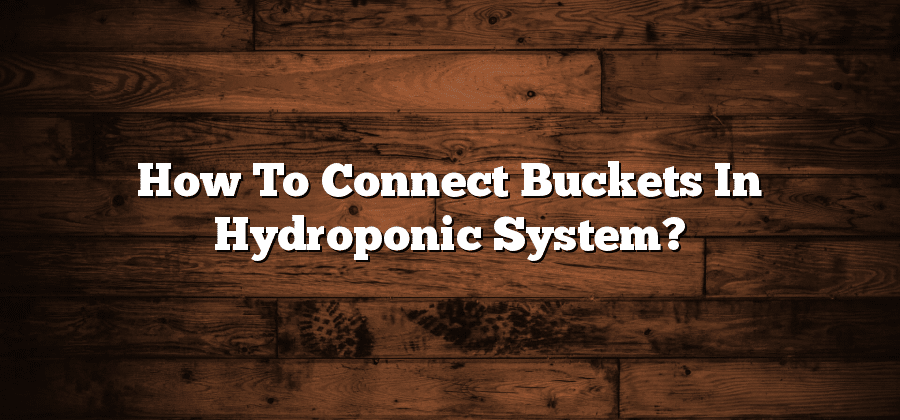Understanding the Hydroponic System Setup
The hydroponic system setup is a method of growing plants without soil. It involves providing a nutrient-rich water solution directly to the plant’s roots, allowing them to absorb the necessary nutrients for growth. This system is becoming increasingly popular among both commercial and home gardeners due to its efficiency and ability to maximize crop yields.
To set up a hydroponic system, several key components are required. These include a reservoir to hold the nutrient solution, a pump to circulate the solution, a grow tray or containers to hold the plants, and a lighting system to provide the necessary light for photosynthesis. Additionally, a pH meter and nutrient testing kit are necessary to monitor and adjust the nutrient solution to ensure optimal growth conditions. Understanding the basics of the hydroponic system setup is crucial to successfully implementing this innovative method of gardening.
Selecting the Right Buckets for Your Hydroponic System
When setting up a hydroponic system, selecting the right buckets is crucial to ensure optimal plant growth and nutrient delivery. The choice of buckets will depend on various factors such as the type of plants being grown, available space, and personal preferences.
Firstly, consider the size of the buckets. Larger plants require larger buckets with sufficient room for root expansion. It is essential to choose buckets that will accommodate the plants’ growth throughout their lifecycle. Additionally, consider the material of the buckets. Food-grade plastic buckets are commonly used in hydroponics as they are durable, lightweight, and resistant to chemicals. However, if you prefer a more environmentally friendly option, there are also biodegradable alternatives made from materials like coconut coir or bamboo fiber. Ultimately, selecting buckets that are compatible with your desired plant species and align with your goals for sustainability will contribute to the overall success of your hydroponic system.
Preparing the Buckets for Connection
Now that you have selected the right buckets for your hydroponic system, it is time to prepare them for connection. This step is crucial to ensure the smooth and efficient flow of water between the buckets.
Start by cleaning the buckets thoroughly with a mild detergent, making sure to remove any dirt or debris. Rinse them well with clean water to ensure there are no residues left behind. Next, drill holes near the bottom of the buckets for the water to pass through. The size of the holes will depend on the specific requirements of your hydroponic system, so be sure to consult the instructions provided by the manufacturer or seek expert advice if needed.
Choosing the Best Method to Connect the Buckets
When it comes to connecting the buckets in a hydroponic system, choosing the right method is crucial for maintaining optimal performance and efficiency. There are several options to consider, each with its own advantages and potential drawbacks. One common method is using a PVC or vinyl tubing to create a continuous flow between the buckets. This method is relatively simple and cost-effective, allowing for easy expansion and adjustability. However, it is important to ensure the tubing is properly fit and sealed to prevent any leaks or blockages. Another popular method is utilizing flexible irrigation pipes with connectors. This method provides flexibility and ease of installation, allowing for precise control of water flow. However, it may require more frequent maintenance to prevent clogging and ensure consistent water distribution. It is essential to carefully evaluate your specific needs and preferences before selecting the best method to connect the buckets in your hydroponic system.
Ensuring Proper Water Flow between Connected Buckets
Proper water flow between connected buckets is essential for the successful operation of a hydroponic system. Without adequate water flow, plants may not receive the necessary nutrients and oxygen, leading to stunted growth or wilting. Therefore, it is crucial to ensure that water flows smoothly and evenly between the connected buckets.
To achieve proper water flow, one key factor to consider is the size and positioning of the connecting tubes. The tubes should be of appropriate diameter to allow sufficient water flow without causing excessive pressure or blockages. Additionally, it is important to position the tubes in such a way that water can freely and evenly reach each bucket without any obstructions. By carefully selecting and positioning the connecting tubes, you can help ensure that water flows smoothly throughout the system, providing optimal conditions for plant growth.
Another important aspect to consider for proper water flow is the use of a reliable and efficient pump. The pump should have enough power to circulate the water between connected buckets and maintain a steady flow. It is recommended to choose a pump that is specifically designed for hydroponic systems, as it will have the necessary features and specifications to ensure proper water flow. Regular maintenance and cleaning of the pump is also crucial to prevent any potential issues that could disrupt water flow. By paying attention to these factors, you can ensure that water flows seamlessly between connected buckets, creating ideal conditions for your hydroponic plants to thrive.






